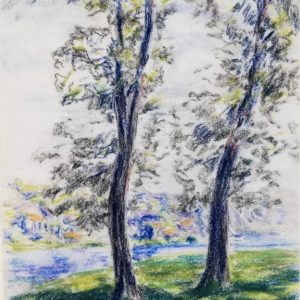
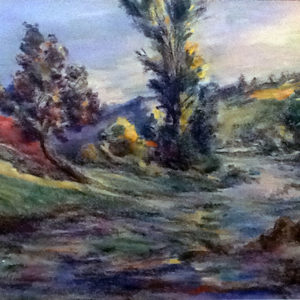
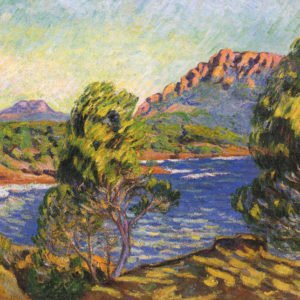
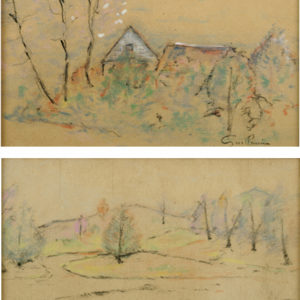
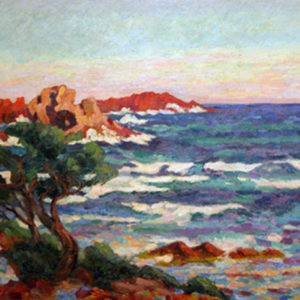
The longest surviving Impressionist, Jean-Baptiste Armand Guillaumin was born in Moulins, but lived mainly in Paris. At age 15 he went to work in his uncle’s shop and studied drawing in the evenings, then pursued his interest in painting while employed on the Paris-Orleans railway.
In 1861 he enrolled at the Academie Suisse where he became friends with Paul Cezanne and Camille Pissaro with whom he painted regularly in the 1860s and 1870s. Guillaumin exhibited in the first Salon des Refusés in 1863 together with Pissarro and Cézanne and in the following two years Renoir and Monet amongst others were added to their ranks. Even at this early stage in his career, Guillaumin was considered an accomplished draughtsman using economic and dynamic strokes to execute remarkably mature compositions. Guillaumin belongs to the first generation of Impressionist painters exhibiting at the Salon des Independants in December 1884, and the Salon d’Automne from 1903. Specializing in landscape painting, Guillaumin participated in the Impressionist exhibitions of 1874-86 at Nadar’s Studio.
In the mid to late 1870s Guillaumin’s handling of the brush becomes lighter and more complex and his palette becomes more luminous in a move away from the style of Manet and Courbet. Both Cézanne and Guillaumin wished to create something solid out of impressionism, to create a sense of underlying form in nature. By 1880 the Impressionist group was beginning to fragment, particular camps forming around Degas and Pissarro with artists drawn to either side. Gauguin was becoming a particularly vocal member of the artistic society of that time and sided heavily with Pissarro, making every effort to include Guillaumin in his cause. Despite their initial misgivings, Renoir and Monet joined the Impressionist Exhibition of 1882 with Guillaumin, Gauguin, and Pissarro, but Degas was conspicuously absent.
Gauguin, a notoriously difficult and egotistical man, went to surprising lengths to keep Guillaumin within the impressionist fold during its fragmentation and during this period he was introduced to a wide range of emerging artists including Redon, Seurat and Signac with whom he formed a lasting friendship. By 1885 Guillaumin’s studio had become a centre for the young group influenced by the work of Pissarro. The emerging artists revered all three artists from the Académie Suisse, but by 1885 the old guard of impressionism had effectively dispersed and the new styles of painting were causing further rifts. Guillaumin saw himself outgrowing the impressionist movement he had been a part of since its outset. However, by the time of the last Impressionist exhibition of 1886 Guillaumin was receiving some rapturous critical appraisal.
In 1887, while discovering the landscapes of La Creuse, which he often painted, Guillaumin met Van Gogh with whom he became close friends and who was to provide an interesting stimulus to Guillaumin’s work. Although Guillaumin by this time was more separate from the avant-garde than he had been since the beginning of the impressionist movement. Van Gogh’s brother, Theo, was an art dealer who began to sell Guillaumin’s work.
In 1891 one of the Bonds he held paid a special premium of 100,000 gold francs, which had a profound effect on his lifestyle. He no longer felt the need to please patrons and critics and was able to pursue his own private artistic goals away from the pressures of the avant-garde. He traveled throughout France in these years, painting a great many mountain and coastal scenes often in the early part of the day or at sunset, and as such, his continual fascination with strong vibrant colors and the effects of light grew.
The Great War provided the only interruption to his traveling which he resumed at its end at the age of 77, visiting his favorite areas of Agay and Crozant. In the 1920’s age was reducing Guillaumin’s output, but instead of being forgotten he was the subject of various monographs and in 1926 a retrospective exhibition at the Salon d’Automne. Critical appreciation of his work reached something of a peak in these years with a monograph by Des Courieres stating that “we have to recognise that in the domain of painting Guillaumin occupies a higher sphere” than Morisot, Sisley and Pissarro. He died amid such praise in 1927.
Guillamin’s work is present in major International collections such as the Kroller-Muller in Holland and the Musee d’Orsay in Paris.